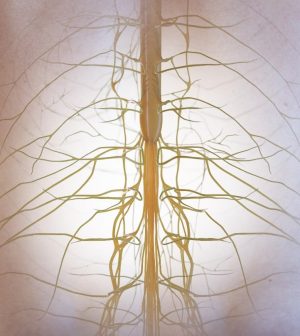- Navigating Your Midlife Crisis: Embracing New Possibilities
- City Raccoons Showing Signs of Domestication
- Mapping the Exposome: Science Broadens Focus to Environmental Disease Triggers
- One Week Less on Social Media Linked to Better Mental Health
- Your Brain Changes in Stages as You Age, Study Finds
- Some Suicide Victims Show No Typical Warning Signs, Study Finds
- ByHeart Formula Faces Lawsuits After Babies Sickened With Botulism
- Switch to Vegan Diet Could Cut Your Greenhouse Gas Emissions in Half
- Regular Bedtime Does Wonders for Blood Pressure
- Dining Alone Could Mean Worse Nutrition for Seniors
Animal Studies Suggest New Treatment Target for Spinal Cord Injury

Spinal cord injuries can cause the body to go haywire, with misfiring nerves causing dangerous “fight-or-flight” responses.
This makes typical and normally harmless problems like having a full bladder prompt life-threatening complications like heart attack, stroke and severe infections like pneumonia.
But researchers think they’ve found a way to treat this condition, which is called autonomic dysfunction.
It’s possible to prevent autonomic dysfunction by depleting the specific type of nerve cell that causes the problem, researchers reported June 12 in the journal Science Translational Medicine.
“We discovered that exaggerated, life-threatening autonomic reflexes after spinal cord injury are associated with abnormal growth and rewiring of nerve fibers in the spinal cord,” said researcher Phillip Popovich, chair of neuroscience at Ohio State University and executive director of Ohio State’s Belford Center for Spinal Cord Injury.
“A specific cell type, called microglia, control this abnormal growth and rewiring,” Popovich said. “Using experimental tools to deplete microglia, we found it’s possible to prevent abnormal nerve growth, and prevent autonomic complications after spinal cord injury.”
This haywire fight-or-flight response can cause the immune system to stall, heart beat to race and blood pressure to surge, researchers said.
There currently are no treatments to prevent the development of autonomic dysfunction in spinal injury patients.
Researchers tested an experimental drug to suppress microglia in lab mice with spinal cord injuries, and found that it could prevent autonomic dysfunction in the animals.
“We consider this a major finding,” said lead researcher Faith Brennan, a neuroscience researcher at Queen’s University in Kingston, Ontario. “Although this is a well-known consequence of spinal cord injury, research has mostly focused on how the injury affects neurons that control autonomic function.”
If this therapy works in humans, it could significantly increase quality of life and life expectancy in spinal cord patients, Popovich said.
The team will next focus on identifying the nerve signals that control microglia and cause them to remodel the spine’s autonomic circuitry, Popovich said.
“Identifying these mechanisms could lead to the design of new, highly specific therapies to treat dysautonomia after spinal cord injury,” Popovich said in an Ohio State news release. “It could also help in other neurological complications where dysautonomia develops, including multiple sclerosis, Alzheimer’s disease, Parkinson’s disease, stroke and traumatic brain injury.”
More information
The Cleveland Clinic has more about autonomic dysfunction.
SOURCE: Ohio State University, news release, June 12, 2024
Source: HealthDay
Copyright © 2025 HealthDay. All rights reserved.










